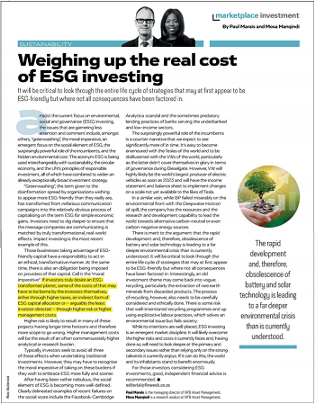Weighing up the real cost of ESG investing
It will be critical to look through the entire life cycle of strategies that may at first appear to be ESG-friendly but where not all consequences have been factored in.


Amidst the current focus on environmental, social and governance (ESG) investing, the issues that are garnering less attention and comment include, amongst others, ‘greenwashing’, the moral imperative, an emergent focus on the social element of ESG, the surprisingly powerful role of the incumbents and the hidden environmental cost. The acronym ESG is being used interchangeably with sustainability, the circular economy, and the UN’s Principles of Responsible Investment, all of which have combined to widen an already exceptionally broad investment strategy.
‘Greenwashing’, the term given to the disinformation spread by organisations wishing to appear more ESG-friendly than they really are, has transformed from nefarious communication campaigns into the relatively obvious process of capitalising on the term ESG for simple economic gains. Investors need to dig deeper to ensure that the message companies are communicating is matched by truly transformational, real-world effects. Impact investing is the most recent example of this.
Those businesses taking advantage of ESG-friendly capital have a responsibility to act in an ethical, transformative manner. At the same time there is also an obligation being imposed on providers of that capital. Call it the ‘moral imperative’. If investors truly desire an ESG-transformed planet, some of the costs of that may have to be borne by the investor themselves, either through higher taxes, an indirect form of ESG capital allocation or - arguably the least investor-directed - through higher risk or higher management costs.
Higher risk is likely to result as many of these projects will have longer time horizons and therefore more scope to go wrong. Higher management costs will be the result of an often commensurately higher analytical or research burden.
Typically, investors seek to avoid all three of these effects when undertaking traditional investments. However, they may have to recognise the moral imperative of taking on these burdens if they wish to embrace ESG more fully and sooner.
After having been rather nebulous, the social element of ESG is becoming more well-defined. Clearly delineated examples of recent failures on the social score include the Facebook-Cambridge Analytica scandal and the sometimes-predatory lending practices of banks serving the under-banked and low-income sectors.
The surprisingly powerful role of the incumbents is a counter-narrative that we expect to see significantly more of in time. It’s easy to become enamoured with the Tesla’s of the world and to be disillusioned with the VWs of the world, particularly as the latter didn’t cover themselves in glory in terms of governance during Dieselgate. However, VW will very likely be the world’s largest producer of electric vehicles as soon as 2023 and will have the income statement and balance sheet to implement changes on a scale not yet available to the likes of Tesla.
In a similar vein, while BP failed miserably on the environmental front with the Deepwater Horizon oil spill, the company has the resources and the research and development capability to lead the world towards alternative carbon-neutral or even carbon-negative energy sources.
There is merit to the argument that the rapid development and, therefore, obsolescence of battery and solar technology is leading to a far deeper environmental crisis than is currently understood. It will be critical to look through the entire life cycle of strategies that may at first appear to be ESG-friendly but where not all consequences have been factored in. Interestingly, an old investment theme may come back into vogue: recycling, particularly the extraction of rare earth minerals from discarded products. The process of recycling, however, also needs to be carefully considered and ethically done. There is some risk that well-intentioned recycling programmes end up using exploitative labour practices which solves an environmental issue but fails society.
While its intentions are well-placed, ESG investing is an emergent market discipline. It will very likely overcome the higher risks and costs it currently faces and, having done so, will need to look deeper at the primary and secondary issues rather than relying only on the strong tailwinds it currently enjoys. If it can do this, the world and its inhabitants stand to benefit enormously.
For those investors considering ESG investments, good, independent financial advice is recommended.
|
This article, "Weighing up the real cost of ESG investing" was written exclusively for Finweek Magazine. It was published in the Finweek edition on page 33. You can access the original print coverage in English here, and in Afrikaans here. |
||
 |
 |
|













